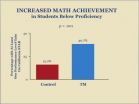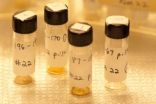Those decisions essentially boil down to which proteins, among all the possible candidates encoded in a cell's genes, the cell will tend to make under ordinary circumstances. But exactly how a cell chooses its default protein selections from an overwhelmingly diverse genetic menu is somewhat mysterious.
A new study from the Stanford University School of Medicine may help solve the mystery. The researchers discovered how a particular variety of the biomolecule RNA that had been thought to be largely irrelevant to cellular processes plays a dynamic regulatory role in protein selection. In unraveling this molecular mechanism, the study also offers enticing clues as to how certain cancers may arise.
Howard Chang, MD, PhD, associate professor of dermatology, is the senior author of the study, to be published online March 20 in Nature.
"All the cells in your body have the same genes, but they don't all make the same proteins," said Chang, MD, PhD, who is also a Howard Hughes Medical Institute Early Career Scientist. In this new study, Chang and his colleagues identified a novel action by a subset of RNA that reinforces cells' decisions about which combinations of their genes are to be active and which must stay silent.
RNA is a chemical lookalike of DNA — the stuff our genes are made of — that, according to standard textbooks, mainly functions as a messenger: a copy of a gene, made by a cell's gene-reading machinery, that can float away from the chromosomes where genes reside to other places in the cell where proteins are made. There the messenger-RNA molecule serves as an instruction manual for the production of proteins.
Scientists used to see RNA mostly as a stodgy servant of its kingly commander, DNA, in the protein-production process. But in recent decades scientists have learned of several ways RNA can influence the production of proteins besides merely conveying information from genes to a cell's protein-making apparatus.
In the Nature study, the researchers identified a novel regulatory role for a class of RNA molecules called lincRNA (for long intergenic noncoding RNA). A typical cell spawns as many as 10,000 distinct species of lincRNA molecules — on a par with the number of conventional protein-coding genes — but lincRNAs don't spell out recipes for making proteins. For years, many biochemists were skeptical that lincRNA played any important role in a cell and considered the molecules just mere "noise," perhaps vestigial protein-coding genes that had mutated to become nonfunctional. Chang's group has been instrumental in proving that lincRNAs can play a critical regulatory role: determining what proteins a cell produces and, thereby, what identity it assumes.
To do so, Chang and his associates turned to human fibroblasts, which are easily grown in culture. Fibroblasts are cells that lie just beneath the skin and secrete factors determining skin cells' local character. "You'll never see hair growing out of someone's palm," Chang said. The factors that fibroblasts secrete vary depending on where in the body they're located.
Remarkably, cultured fibroblasts from different parts of the body somehow remember their sense of where they belong, continuing to maintain characteristic patterns of genes that are "on" or "off" even over dozens of generations of cell division in a petri dish. "Why is that?" Chang asked.
A related question intrigued the study's first author, Kevin Wang, MD, PhD, an instructor of dermatology and a postdoctoral scholar in Chang's lab. "I was initially interested in conditions like psoriasis, a skin disease whose manifestations in the body are region-specific," he said. "Cells that have the same DNA, that look the same under a microscope — what made them act differently?"
Chang has been using cultured fibroblasts as workhorse cells to help answer these questions. In a study published last year in Science, his group showed that one species of lincRNA, which he and his labmates had discovered and named HOTAIR, acts quite differently from your standard mRNA molecule: It contorts into a kind of adapter plug and then latches onto massive protein complexes, which have the ability to silence genes. Once hooked up to such complexes, HOTAIR shuttles them to particular spots along a chromosome — "positional identity" genes. Defects in these genes, first identified in fruit flies, can result in bizarre outcomes such as a fly with legs growing out of its head, instead of antennae. Particular on/off patterns of a cell's positional-identity genes lead the cell to behave in a characteristic way (palm versus scalp, for example).
In a nutshell, HOTAIR locks cells' positional identities into place by marking key genes with the biochemical equivalent of "gone fishing" signs, so that they remain closed for business.
The new study, in contrast, demonstrates how another lincRNA, dubbed HOTTIP, grabs onto an opposing type of protein complex, which marks similar positional-identity genes as "open for business." The researchers observed that this complex wheels into action once HOTTIP links to it, and then biochemically fixes cell-position-appropriate genes in the "on" position.
An ability to act as a mute button for protein production has been demonstrated for other RNA types besides lincRNA. But, said Chang, HOTTIP is the first example of any RNA molecule that creates a memory of gene activation rather than silencing them. "When we experimentally impeded HOTTIP activity, fibroblasts that were supposed to express certain positional-identity genes didn't," he said.
Interestingly, the particular genes that HOTTIP caused to retain a switched-on status were fairly remote from one another along the stretch of chromosome where they reside. To learn more about how this works, Chang, Wang and their Stanford colleagues teamed up with a group at the University of Massachusetts Medical School, in Worcester, whose research focuses on the three-dimensional organization of genomes.
What they learned from this holds implications for how some cancers could get started. The investigators found that DNA can form complicated looping structures that bring genes distant from one another on a chromosome, or on entirely different chromosomes, physically close. This lets HOTTIP and the protein complex it's linked to efficiently mark appropriate genes as "open for business."
But it could also lead to things going awry, possibly triggering certain cancers. Biochemical interactions at close range among these ordinarily distant genes can cause their fusion — or even an exchange in their positions — and resulting faulty protein production characteristic of a number of cancers, Chang said.
###
The study was funded by the California Institute for Regenerative Medicine, the National Institutes of Health, the Scleroderma Research and W.M. Keck foundations and the Howard Hughes Medical Institute. Other Stanford co-authors are Joanna Wysocka, PhD, assistant professor of chemical and systems biology and of developmental biology; Jill Helms, PhD, DDS, professor of surgery; Rajnish Gupta, MD, PhD, clinical assistant professor of dermatology; Bo Liu PhD, a research associate in Helms' laboratory; medical and graduate student Yul Yang; graduate student Ryan Corces-Zimmerman; medical student Ryan Flynn; and research assistant Angeline Protacio. In addition to the team at the University of Massachusetts, the study also involved a researcher at the University of Michigan.
More information about Stanford's Department of Dermatology, which supported this work, is available at http://dermatology.stanford.edu/.
The Stanford University School of Medicine consistently ranks among the nation's top medical schools, integrating research, medical education, patient care and community service. For more news about the school, please visit http://mednews.stanford.edu. The medical school is part of Stanford Medicine, which includes Stanford Hospital & Clinics and Lucile Packard Children's Hospital. For information about all three, please visit http://stanfordmedicine.org/about/news.html.
PRINT MEDIA CONTACT: Bruce Goldman at (650) 725-2106 (goldmanb@stanford.edu)
BROADCAST MEDIA CONTACT: M.A. Malone at (650) 723-6912 (mamalone@stanford.edu)
END

